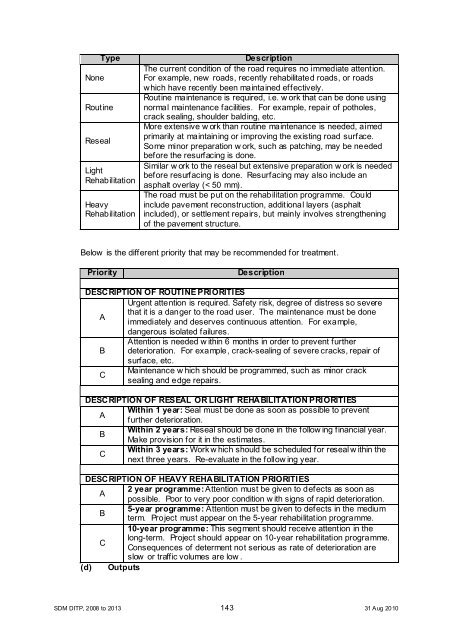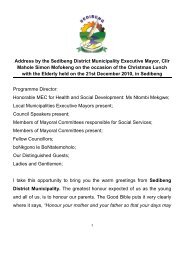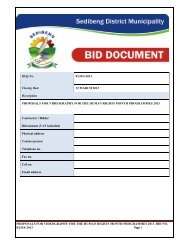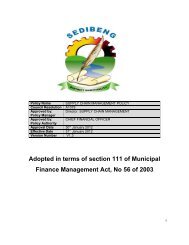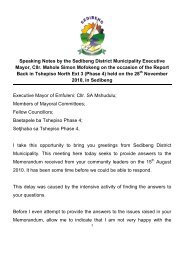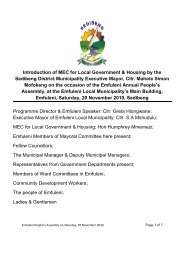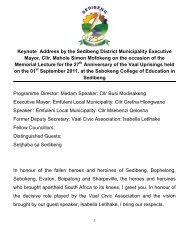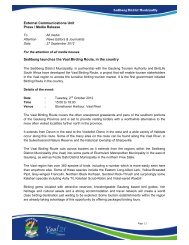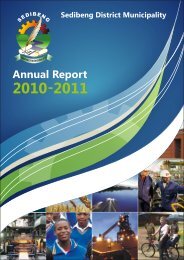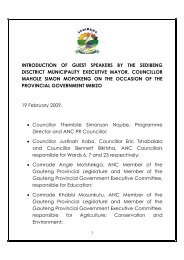Chapter 11 - Sedibeng District Municipality
Chapter 11 - Sedibeng District Municipality
Chapter 11 - Sedibeng District Municipality
Create successful ePaper yourself
Turn your PDF publications into a flip-book with our unique Google optimized e-Paper software.
None<br />
Type<br />
Routine<br />
Reseal<br />
Light<br />
Rehabilitation<br />
Heavy<br />
Rehabilitation<br />
Description<br />
The current condition of the road requires no immediate attention.<br />
For example, new roads, recently rehabilitated roads, or roads<br />
which have recently been maintained effectively.<br />
Routine maintenance is required, i.e. w ork that can be done using<br />
normal maintenance facilities. For example, repair of potholes,<br />
crack sealing, shoulder balding, etc.<br />
More extensive w ork than routine maintenance is needed, aimed<br />
primarily at maintaining or improving the existing road surface.<br />
Some minor preparation w ork, such as patching, may be needed<br />
before the resurfacing is done.<br />
Similar w ork to the reseal but extensive preparation w ork is needed<br />
before resurfacing is done. Resurfacing may also include an<br />
asphalt overlay (< 50 mm).<br />
The road must be put on the rehabilitation programme. Could<br />
include pavement reconstruction, additional layers (asphalt<br />
included), or settlement repairs, but mainly involves strengthening<br />
of the pavement structure.<br />
Below is the different priority that may be recommended for treatment.<br />
Priority<br />
Description<br />
DESCRIPTION OF ROUTINE PRIORITIES<br />
Urgent attention is required. Safety risk, degree of distress so severe<br />
that it is a danger to the road user. The maintenance must be done<br />
A<br />
immediately and deserves continuous attention. For example,<br />
dangerous isolated failures.<br />
Attention is needed w ithin 6 months in order to prevent further<br />
B deterioration. For example, crack-sealing of severe cracks, repair of<br />
surface, etc.<br />
Maintenance w hich should be programmed, such as minor crack<br />
C<br />
sealing and edge repairs.<br />
DESCRIPTION OF RESEAL OR LIGHT REHABILITATION PRIORITIES<br />
Within 1 year: Seal must be done as soon as possible to prevent<br />
A<br />
further deterioration.<br />
Within 2 years: Reseal should be done in the follow ing financial year.<br />
B<br />
Make provision for it in the estimates.<br />
Within 3 years: Work w hich should be scheduled for reseal w ithin the<br />
C<br />
next three years. Re-evaluate in the follow ing year.<br />
DESCRIPTION OF HEAVY REHABILITATION PRIORITIES<br />
2 year programme: Attention must be given to defects as soon as<br />
A<br />
possible. Poor to very poor condition w ith signs of rapid deterioration.<br />
5-year programme: Attention must be given to defects in the medium<br />
B<br />
term. Project must appear on the 5-year rehabilitation programme.<br />
10-year programme: This segment should receive attention in the<br />
long-term. Project should appear on 10-year rehabilitation programme.<br />
C<br />
Consequences of determent not serious as rate of deterioration are<br />
slow or traffic volumes are low .<br />
(d) Outputs<br />
SDM DITP, 2008 to 2013 143 31 Aug 2010


